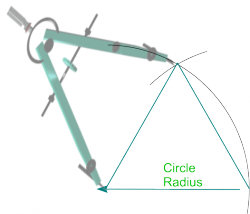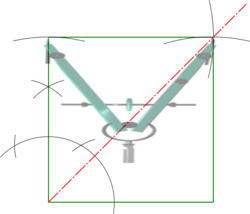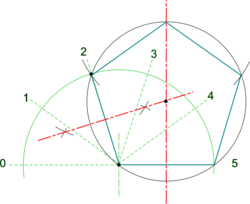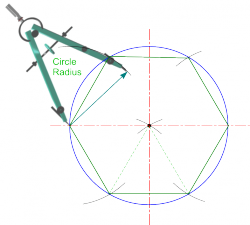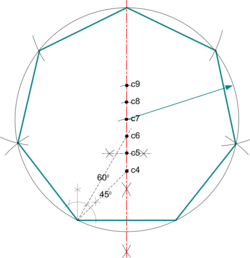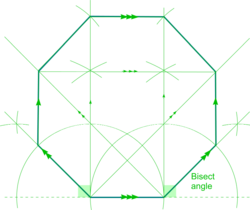Polygons: Difference between revisions
From DT Online
(Added septagon) |
mNo edit summary |
||
| (7 intermediate revisions by the same user not shown) | |||
| Line 1: | Line 1: | ||
__TOC__ | |||
=====Description===== | |||
Drawing regular [https://en.wikipedia.org/wiki/Polygon '''Polygons'''] is now most easily accomplished using modern [https://en.wikipedia.org/wiki/Technical_drawing '''drafting'''] aids and [https://en.wikipedia.org/wiki/Computer-aided_design '''Computer Aided Design'''] tools. But there are occasions when it is useful to have an understanding of some basic constructions using just rule and compasses ''(or pegs and pieces of string)''. Examples might include large scale work for stage sets or carnival floats, or on-site work for buildings, playgrounds, sports fields and gardens. | Drawing regular [https://en.wikipedia.org/wiki/Polygon '''Polygons'''] is now most easily accomplished using modern [https://en.wikipedia.org/wiki/Technical_drawing '''drafting'''] aids and [https://en.wikipedia.org/wiki/Computer-aided_design '''Computer Aided Design'''] tools. But there are occasions when it is useful to have an understanding of some basic constructions using just rule and compasses ''(or pegs and pieces of string)''. Examples might include large scale work for stage sets or carnival floats, or on-site work for buildings, playgrounds, sports fields and gardens. | ||
| Line 11: | Line 16: | ||
</span> | </span> | ||
---- | ---- | ||
=====Constructions===== | |||
{| cellpadding="5" | {| cellpadding="5" | ||
| Line 18: | Line 25: | ||
* Draw a line of length equal to the length of side required. | * Draw a line of length equal to the length of side required. | ||
* From each end of the line, strike arcs using the line length as radius. | * From each end of the line, strike arcs using the line length as radius. | ||
* Where they intersect will provide the top apex of the required triangle. </span> | * Where they intersect will provide the top [https://en.wikipedia.org/wiki/Apex_%28geometry%29 '''apex'''] of the required triangle. </span> | ||
| [[File:CompassTriangle.png|250px|right]] | | [[File:CompassTriangle.png|250px|right]] | ||
|- | |- | ||
| Line 25: | Line 32: | ||
* Draw a line of length equal to the length of side required. | * Draw a line of length equal to the length of side required. | ||
* From one end of the line construct a perpendicular - (see '''[[Basic Constructions]]'''). | * From one end of the line construct a perpendicular - (see '''[[Basic Constructions]]'''). | ||
* Set the line length as a radius and strike an arc along the | * Set the line length as a radius and strike an arc along the perpendicular to find the second side of the square. | ||
* Keep the same radius and strike arcs from the ends of the two adjacent sides as shown | * Keep the same radius and strike arcs from the ends of the two adjacent sides as shown | ||
* Joining to where the two arcs intersect provides the remaining two sides. | * Joining to where the two arcs intersect provides the remaining two sides. | ||
| Line 34: | Line 41: | ||
| <span style="color:#B00000"> | | <span style="color:#B00000"> | ||
* Draw a line of length equal to the length of side required and construct its perpendicular bisector - (see '''[[Basic Constructions]]'''). | * Draw a line of length equal to the length of side required and construct its perpendicular bisector - (see '''[[Basic Constructions]]'''). | ||
* Draw a semi-circle at one end of the line and divide its circumference into as many equal parts as there are polygon sides required ''(5 in this case)'' | |||
* The line connecting the semi-circle centre to the 2nd point is a side of the required polygon ''(pentagon in this case)''. | |||
* Construct the perpendicular bisector of this second side to intersect with that drawn for the base line. | |||
* Where the two bisectors intersect is the centre for a [https://en.wikipedia.org/wiki/Circumscribed_circle '''circumscribing circle'''] to the required polygon. | |||
* Draw the circle and step off the required number of sides. | |||
---- | ---- | ||
<span style="color: green">'''Note:''' | <span style="color: green">'''Note:''' | ||
Polygons with odd numbered sides have an apex at top centre and this can be used for greater accuracy as an | Polygons with odd numbered sides have an apex at top centre and this can be used for greater accuracy as an alternative starting point, or as check, when stepping off sides round the circle . | ||
</span> | |||
---- | |||
<span style="color: green">'''Note:''' | |||
This construction may be used for other polygons by stepping off an appropriate number of sides around the semi-circle - but in all cases always start by drawing a line through the 2nd division to establish the circumscribing circle centre. | |||
</span> | </span> | ||
---- | ---- | ||
| Line 49: | Line 65: | ||
---- | ---- | ||
<span style="color: green">'''Note:''' | <span style="color: green">'''Note:''' | ||
Polygons with even numbers of sides have diagonals parallel to the sides and this can be used as a check on accuracy | |||
</span> | </span> | ||
---- | ---- | ||
| Line 55: | Line 71: | ||
| [[File:CompassHex.png|250px|right]] | | [[File:CompassHex.png|250px|right]] | ||
|- | |- | ||
| '''Septagon''' | | '''Heptagon (aka Septagon)''' | ||
| <span style="color:#B00000"> | | <span style="color:#B00000"> | ||
* Draw a line of length equal to the length of side required and construct its perpendicular bisector - (see '''[[Basic Constructions]]'''). | * Draw a line of length equal to the length of side required and construct its perpendicular bisector - (see '''[[Basic Constructions]]'''). | ||
| Line 63: | Line 79: | ||
---- | ---- | ||
<span style="color: green">'''Note:''' | <span style="color: green">'''Note:''' | ||
A circle centred here would circumscribe a pentagon and provides an alternative construction. | |||
</span> | </span> | ||
---- | ---- | ||
* Set radius to half the distance between c4 and c6 and step off above c6 to create c7 - the centre of a circle which circumscribes a | * Set radius to half the distance between c4 and c6 and step off above c6 to create c7 - the centre of a circle which circumscribes a Heptagon ''(aka Septagon)'' | ||
* Set radius to the length of side and step off round the circle. | * Set radius to the length of side and step off round the circle. | ||
</span> | </span> | ||
| Line 73: | Line 89: | ||
| '''Octagon''' | | '''Octagon''' | ||
| <span style="color:#B00000"> | | <span style="color:#B00000"> | ||
* | * Draw a line of length equal to the length of side required and draw a semi-circle from each end | ||
* Use the semi-circle arcs to construct perpendiculars from each end of the line - (see '''[[Basic Constructions]]'''). | |||
* Bisect the exterior angles at the base to create 45<sup>0</sup> angles as shown. | |||
* Where these bisectors cut the semi-circles are two sides of the octagon. | |||
* Draw lines from the other end of the line through the top centre of the semi-circle - these will be parallel to the bisectors. | |||
* Draw perpendiculars from where the 45<sup>0</sup> lines intersect the semi-circles up to their intersection with lines through the tops of the semi-circles - these are two vertical sides of the octagon. | |||
* Complete the octagon by scribing lengths of sides from the ends of these vertical sides on to the first perpendiculars drawn as shown. | |||
* Check the accuracy of all points by ensuring diagonals are parallel to sides. | |||
</span> | |||
| [[File:CompassOctagon.png|250px|right]] | | [[File:CompassOctagon.png|250px|right]] | ||
|} | |} | ||
{{Drawing Instruments Buyers Guide}} | |||
[[Category:Secondary]] | |||
[[Category:Geometry]] | |||
Latest revision as of 10:04, 7 June 2018
Description
Drawing regular Polygons is now most easily accomplished using modern drafting aids and Computer Aided Design tools. But there are occasions when it is useful to have an understanding of some basic constructions using just rule and compasses (or pegs and pieces of string). Examples might include large scale work for stage sets or carnival floats, or on-site work for buildings, playgrounds, sports fields and gardens.
The following examples are limited to constructions of regular polygons. Irregular polygon construction may be achieved using a process of triangulation, vectors, coordinates or plotting points on a matrix for example. Some other polygons (e.g. Cyclic Quadlitateral) have particular properties which can be helpful to know when constructing them.
See also the YouTube video All the possible polygons!. This shows how all regular polygons can be constructed using classical geometry techniques
Note: Some constructions on the YouTube video may be different to those described below - there are several methods of construction possible for most regular polygons.
Constructions
| Equilateral Triangle |
|
|
| Square |
|
|
| Pentagon |
Note: Polygons with odd numbered sides have an apex at top centre and this can be used for greater accuracy as an alternative starting point, or as check, when stepping off sides round the circle . Note: This construction may be used for other polygons by stepping off an appropriate number of sides around the semi-circle - but in all cases always start by drawing a line through the 2nd division to establish the circumscribing circle centre.
|
|
| Hexagon |
Note: Polygons with even numbers of sides have diagonals parallel to the sides and this can be used as a check on accuracy
|
|
| Heptagon (aka Septagon) |
Note: A circle centred here would circumscribe a pentagon and provides an alternative construction.
|
|
| Octagon |
|
